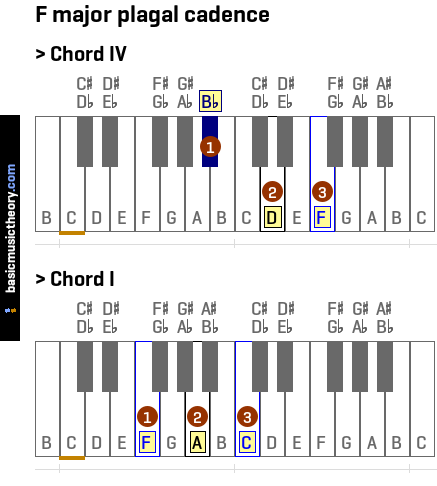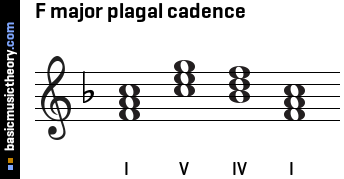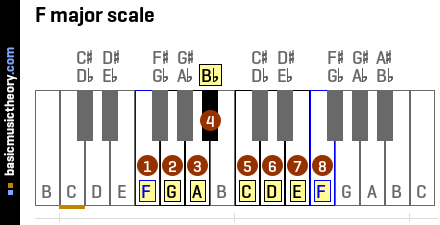F major plagal cadence
The Solution below shows the F major plagal cadence on the piano and treble clef.
The Lesson steps then describe the cadence structure in this key, the chords used, followed by an example of its use.
For a quick summary of this topic, have a look at Cadence.
| Key | C | C# | Db | D | D# | Eb | E | E# | Fb | [F] | F# | Gb | G | G# | Ab | A | A# | Bb | B | B# | Cb |
|---|
Solution
1. F major plagal cadence
The plagal cadence moves from the subdominant (IV), to the tonic (I) scale degree.
So in this major key, we are going from the F major triad chord #IV - Bb major chord, to F major triad chord #I - F major chord.
This is more commonly known as the Amen cadence, used at the end of many hymns.


To demonstrate this, on the treble clef above, chords F major triad chord #I and F major triad chord #V are used to set up the phrase as being in this key, then the cadence chords IV and I finish off the phrase, giving only a partial sense of completion, in comparison to the F major perfect authentic cadence.
| Treble Clef: | Midi | MP3 |
Lesson steps
1. Cadence Types
Cadence definition
In music theory, a cadence is two chords which create a sense of closure, or rest to a phrase, section, or entire piece of music.
The most commonly used are: perfect authentic, imperfect authentic, plagal, deceptive and half cadence.
Some of the above are US-english terms. In the UK, authentic cadences are called perfect cadences, half cadences are called imperfect cadences, and deceptive cadences are called interrupted cadences.
Cadences - strong versus weak
Each of the above cadence types use different chords (or inversions) to create these rest / closure effects.
Strong cadences give a real sense of finality, and so are most often used right at the end of a piece.
In contrast, weak cadences are less conclusive, which can be used to create a sense of rest, or even surprise the listener with a false ending, when a strong cadence was expected in its place.
2. F major scale notes and chords
Before describing the details of the plagal cadence in the key of F major, first it would be to useful to identify the scale notes, degrees and chords that could be used in this key.
F major scale notes
Below is a piano diagram showing the F major scale notes.

F major scale chords
For details on all the chords in this scale, have a look at F major triad chords, and F major 7th chords, but a summary table of all chord names and their scale degrees is shown below.
| Note no. | Note name | Scale degree | Triad chord # | 7th chord # |
|---|---|---|---|---|
| 1 | F | tonic | F major triad chord #I | F major seventh chord #I7 |
| 2 | G | supertonic | F major triad chord #ii | F major seventh chord #ii7 |
| 3 | A | mediant | F major triad chord #iii | F major seventh chord #iii7 |
| 4 | Bb | subdominant | F major triad chord #IV | F major seventh chord #IV7 |
| 5 | C | dominant | F major triad chord #V | F major seventh chord #V7 |
| 6 | D | submediant | F major triad chord #vi | F major seventh chord #vi7 |
| 7 | E | leading tone | F major triad chord #viio | F major seventh chord #viiø7 |
For each note in the scale (2nd column), there is a triad chord whose root / first note is that scale note (4th column), and the same applies to 7th chords (5th column).
To understand what the roman numerals mean, please look at F major triad chords or F major 7th chords.
According to the cadence type, some of these chords, scale degrees and roman numerals will be used in later steps to define this cadence.
| Bass Clef: | Midi | MP3 | Treble Clef: | Midi | MP3 |
3. F major plagal cadence
Structure
The plagal cadence moves from the subdominant (IV), to the tonic (I) scale degree.
So looking up the chords relating to these scale degrees from the table above, we are going from the F major triad chord #IV - Bb major chord, to F major triad chord #I - F major chord.
This is known as the Amen cadence because of its use in at the end of hymns.
It is a weaker closure than the F major perfect authentic cadence, whose dominant to tonic motion is the most important relationship in a diatonic scale, and gives the strongest sense of closure of all cadences.

Example
The two chords above are shown as the last two chords on the treble clef below.
The first two chords on the staff below are not strictly part of the cadence, but they are useful to set the expectation that this phrase is definitely in the key of F major.
To do this, we are using chords F major triad chord #I and F major triad chord #V, and after hearing these chords, the ear could expect to hear chord I again.
If instead the F major triad chord #IV is inserted before the final chord I, this gives less sense of closure and completion than arriving at chord I directly from chord V.
The audio files below also contain all 4 chords shown on the treble clef above.
| Treble Clef: | Midi | MP3 |
| Key | C | C# | Db | D | D# | Eb | E | E# | Fb | [F] | F# | Gb | G | G# | Ab | A | A# | Bb | B | B# | Cb |
|---|